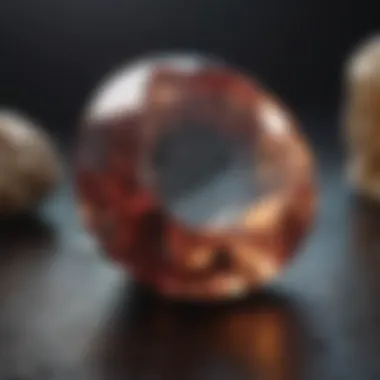Master the Art of Rock Tumbling: A Comprehensive Guide


Rock and Fossil Identification
In the realm of rock tumbling, a crucial first step is identifying the right types of rocks and fossils to work with. Understanding the different characteristics to look for in rocks is essential for a successful tumbling process. Various tools can aid in this identification process, such as magnifying glasses, scratch test kits, and UV lights to reveal hidden patterns or compositions.
Collecting Tips and Techniques
Once the rocks and fossils have been identified, the next phase involves collecting them effectively. Implementing best practices when collecting specimens ensures both the quality of the material and the preservation of the surrounding environment. Rock tumblers should seek out prime collecting sites known for yielding high-quality rocks and fossils. When extracting specimens, it is important to use proper techniques to avoid damaging the material and ensure personal safety.
Preservation and Display
Preserving the rocks and fossils post-tumbling requires specific techniques to maintain their beauty and integrity. Proper storage methods, such as using airtight containers or padded display cases, help prevent damage from environmental factors. Creative display ideas can elevate the overall aesthetic appeal of the polished gemstones, from arranging them in decorative shadow boxes to incorporating them into jewelry pieces.
Geological Insights
Delving into the geological aspects of rock tumbling provides enthusiasts with a deeper appreciation for the origins and processes behind the rocks and fossils. Exploring geological formations and processes sheds light on how different types of rocks are created over time. Understanding the historical significance of certain rocks and fossils can add another layer of intrigue to the tumbling process. Learning about notable discoveries in the field offers insights into the diversity and rarity of different specimens, enriching the overall rock tumbling experience.
Introduction to Rock Tumbling
In this comprehensive rock tumbling guide, the Introduction to Rock Tumbling sets the foundation for enthusiasts to embark on a journey into the world of polished gemstones. Understanding the significance of this segment is pivotal as it provides a roadmap for novices and seasoned collectors alike. By delving into the core principles of rock tumbling, individuals can grasp the artistry and meticulous process that goes into transforming rough stones into lustrous treasures. Offering a glimpse into the intricate steps involved, this section serves as a crucial entry point for readers to grasp the nuances of rock tumbling.
What is Rock Tumbling?
Rock tumbling is a captivating process that entails polishing rough stones and minerals to enhance their beauty and luster. Through the methodical use of abrasives and polishing agents, stones are tumbled in a machine for an extended period, gradually refining their surfaces and revealing their inherent colors and patterns. This transformative process allows enthusiasts to showcase the natural brilliance of various rocks, turning them into exquisite gemstones ready for display or jewelry making.
History of Rock Tumbling
The history of rock tumbling dates back thousands of years, with civilizations such as the Egyptians and Greeks utilizing rudimentary methods to polish stones for decorative purposes. Over time, advancements in technology and abrasive materials have revolutionized the art of rock tumbling, making it more accessible to hobbyists and professionals alike. Understanding the evolution of rock tumbling not only gives insight into its enduring popularity but also highlights the craftsmanship and innovation that have shaped this ancient practice into a modern-day art form.
Benefits of Rock Tumbling
Engaging in rock tumbling offers a plethora of benefits beyond the creation of stunning gemstones. It provides a therapeutic and meditative outlet for individuals seeking a creative and hands-on hobby. Moreover, rock tumbling allows enthusiasts to connect with nature by uncovering the hidden beauty within ordinary stones, fostering a deeper appreciation for the earth's geological wonders. Additionally, the process of rock tumbling promotes patience, attention to detail, and a sense of accomplishment as rough rocks are transformed into polished treasures, making it a rewarding and enriching pursuit for collectors of all ages.


Selecting the Right Rocks
Selecting the right rocks is a crucial aspect of rock tumbling, as it determines the outcome of the entire process. The choice of rocks plays a vital role in the quality of the final polished gemstones. By carefully picking suitable rocks, rock tumblers can achieve stunning results that showcase the natural beauty of the materials.
When it comes to Identifying Suitable Rocks, two key factors come into play: Hardness and Durability and Color and Pattern. These elements significantly impact the success of rock tumbling and are worth exploring in detail.
Hardness and Durability are fundamental characteristics to consider when selecting rocks for tumbling. Rocks with high hardness and durability are ideal for the tumbling process because they can withstand the abrasive actions of grinding and polishing. Their sturdy nature ensures that the rocks maintain their shape and integrity throughout the tumbling stages, leading to superior end results. The advantage of using hard and durable rocks is their longevity and ability to resist crumbling or breaking during tumbling, providing a smoother and more efficient process.
Conversely, Color and Pattern also play a crucial role in rock selection. Rocks with vibrant colors and interesting patterns can result in visually appealing polished gemstones. The aesthetics of the final product are greatly influenced by the initial colors and patterns present in the rocks chosen for tumbling. As light interacts with the polished surface, unique colorations and patterns become more pronounced, enhancing the beauty of the gemstones. While considering color and pattern, it is essential to balance visual appeal with rock hardness to achieve optimal results in the tumbling process.
In the world of rock tumbling, several rocks stand out as Popular Rocks for Tumbling. Each type of rock offers distinct qualities that impact the polishing outcome. Understanding the properties and characteristics of these popular rocks can guide rock enthusiasts in their selection process, steering them towards desirable results.
On the flip side, Avoiding Unsuitable Rocks is equally important to ensure a successful tumbling experience. Certain rocks may be too soft, brittle, or porous to withstand the tumbling process, leading to unsatisfactory results. By being aware of rocks that are unsuitable for tumbling, enthusiasts can save time and resources while focusing on materials that are better suited for achieving polished gemstones of exceptional quality.
Equipment and Supplies
In the comprehensive world of rock tumbling, the topic of Equipment and Supplies emerges as a pivotal aspect that sets the foundation for successful tumbling endeavors. Without the proper equipment and supplies, the art of rock tumbling would be challenging to master. From selecting the right tumbler to choosing the essential supplies, each component plays a vital role in the overall tumbling process. Equipment and Supplies serve as the backbone of rock tumbling, ensuring that enthusiasts can transform rough rocks into polished gemstones with precision and finesse.
Tumbler Types
Rotary Tumblers
Rotary tumblers stand out as a cornerstone in the realm of rock tumbling, offering a robust and efficient tumbling experience for enthusiasts. The key characteristic of Rotary Tumblers lies in their ability to provide consistent and uniform tumbling action, resulting in evenly polished rocks. This makes Rotary Tumblers a popular choice for rock tumblers seeking high-quality finishes and streamlined operation. One unique feature of Rotary Tumblers is their versatility in handling various types of rocks, from softer materials to more durable specimens. While Rotary Tumblers excel in producing polished gemstones, they may require longer tumbling durations compared to other tumbler types.
Vibratory Tumblers
On the other hand, Vibratory Tumblers present a distinct approach to rock tumbling, known for their fast and efficient tumbling action. The key characteristic of Vibratory Tumblers lies in their ability to achieve quicker tumbling cycles, making them ideal for enthusiasts looking for rapid results. This characteristic makes Vibratory Tumblers a beneficial choice for those seeking shorter tumbling durations and increased efficiency in the tumbling process. One unique feature of Vibratory Tumblers is their gentle tumbling motion, which is particularly suitable for delicate or fragile rocks. While Vibratory Tumblers are efficient in polishing rocks, they may produce slightly louder operation noises compared to Rotary Tumblers.
Essential Supplies
In the realm of rock tumbling, essential supplies like grits and polishing compounds play a crucial role in enhancing the tumbling process. Grits and Polishing Compounds contribute to the overall quality of the tumbling results by facilitating the grinding and polishing stages effectively. The key characteristic of Grits and Polishing Compounds lies in their ability to remove imperfections and achieve a smooth, shiny finish on rocks. This characteristic makes them a popular choice among rock tumblers aiming for professional-quality outcomes. One unique feature of Grits and Polishing Compounds is their graded abrasiveness, allowing tumblers to progress from coarse grinding to fine polishing with precision. While Grits and Polishing Compounds are essential for rock tumbling, they require careful handling and proper application to prevent over-tumbling or under-polishing.


Tumbling Media
Similarly, Tumbling Media plays a vital role in the rock tumbling process, aiding in the efficient movement of rocks within the tumbler. The key characteristic of Tumbling Media lies in its ability to cushion and support the rocks during tumbling, preventing damage and promoting uniform polishing. This characteristic makes Tumbling Media a beneficial choice for rock tumblers seeking consistent results and reduced risk of chipped or scratched rocks. One unique feature of Tumbling Media is its varying compositions, including ceramic, plastic, or natural materials, each offering different levels of abrasiveness. While Tumbling Media enhances the tumbling process, it requires regular maintenance and replacement to ensure optimal performance and results.
Safety Precautions
Rock tumbling, while a rewarding hobby, comes with inherent risks that necessitate the implementation of safety precautions. Prioritizing safety measures during the tumbling process is crucial to prevent accidents and injuries. Enthusiasts should pay particular attention to safety guidelines when handling tumbling equipment and supplies to safeguard their well-being and promote a safe tumbling environment. By adhering to safety precautions, rock tumblers can enjoy the process while ensuring a secure and protected tumbling experience.
Rock Tumbling Process
In the realm of rock tumbling, the process is a crucial stage that elevates a rough stone into a polished gem. It forms the essence of this guide, delving deep into the steps and intricacies necessary to achieve breathtaking results. The Rock Tumbling Process is a transformative journey that emphasizes patience, precision, and a profound understanding of materials.
Coarse Grinding
Coarse grinding marks the inception of the rock tumbling process, where rough stones are subjected to the initial abrasion to smoothen their surfaces. This critical stage aims to remove imperfections, reshape the stone, and lay the foundation for subsequent grinding and polishing. Choosing the right grit size and duration is paramount during coarse grinding to ensure the optimal shaping of the stone without causing damage. Through a carefully monitored process, enthusiasts can witness the gradual evolution of their raw specimens into refined entities ready for further refinement.
Fine Grinding
Following the coarse grinding phase, fine grinding takes center stage, refining the surfaces of the stones to a higher degree of smoothness and uniformity. This step involves using progressively finer grits to achieve a polished appearance while eradicating any remaining imperfections from the previous stages. Fine grinding demands attention to detail and an eye for precision, as slight variations in technique can significantly influence the final outcome of the tumbling process. By navigating through this phase with diligence and expertise, enthusiasts can unlock the true beauty hidden within their chosen rocks.
Polishing Stage
The polishing stage crowns the rock tumbling process, imparting a lustrous sheen and mirror-like finish to the stones. This final step elevates the aesthetic appeal of the rocks, showcasing their vibrant colors and unique patterns in all their glory. Utilizing specialized polishing compounds and tumbling media, enthusiasts can achieve a professional-level gloss that dazzles the eyes and captivates the imagination. The polishing stage is where dedication meets artistry, culminating in the transformation of rough stones into exquisite gemstones that radiate beauty and elegance.
Finishing Touches
Rock tumbling enthusiasts understand that the finishing touches are not only the final steps in the process but also crucial for achieving stunning results. After the rocks have gone through the grinding and polishing stages, the Finishing Touches section ensures that the polished gemstones are flawless and ready to be admired. This section delves into the importance of perfecting the rocks and bringing out their true beauty.
Cleaning and Drying
Cleaning and drying the polished rocks is a meticulous task that cannot be underestimated. This crucial step ensures that any residual grit or polish is removed, leaving the gemstones sparkling and pristine. By detailing the importance of thorough cleaning and gentle drying techniques, rock tumblers can guarantee the quality and shine of their final products. It is essential to discuss suitable cleaning methods and emphasize the significance of proper drying to prevent any damage to the gems.


Inspecting the Polished Rocks
Inspecting the polished rocks allows tumblers to closely examine their handiwork. This step is essential for identifying any imperfections or areas that may require further attention. By exploring how to conduct a thorough inspection, enthusiasts can ensure that their gemstones meet their desired standards of perfection. Discussing the key aspects to look out for during the inspection process will empower rock tumblers to refine their skills and produce exceptional results.
Storage Tips
Effective storage of polished rocks is crucial to maintain their luster and protect them from damage. This section offers insights into the best practices for storing gemstones, including the importance of proper containers and environments to preserve their beauty. By outlining practical storage tips, rock tumblers can prolong the lifespan of their creations and showcase them in pristine condition. Highlighting the significance of suitable storage methods will help collectors appreciate their polished rocks for years to come.
Common Issues and Troubleshooting
Rock tumbling, like any craft, comes with its set of challenges and potential pitfalls. Understanding common issues and troubleshooting techniques is pivotal in mastering the art of rock tumbling. This section delves deep into the importance of addressing and resolving difficulties that may arise during the tumbling process.
Over-Tumbling
Sometimes, in the pursuit of achieving perfectly polished rocks, enthusiasts tend to over-tumble their specimens. Over-tumbling can result in rounded edges losing their sharpness and distinct features being eroded. It is essential to strike a balance between tumbling adequately for desired smoothness and avoiding excessive tumbling that leads to undesired outcomes. By recognizing the signs of over-tumbling and adjusting tumbling durations accordingly, collectors can preserve the integrity of their rocks while attaining the desired polish.
Uneven Polishing
Uneven polishing is another challenge that rock tumblers may encounter. This issue manifests as certain areas of a rock being more polished than others, causing an imbalance in the final appearance. Uneven polishing can result from imbalanced tumbling loads, irregularly shaped rocks, or inadequate distribution of polishing grit. Implementing strategies such as rotating the tumbling barrel regularly, using proper load sizes, and ensuring uniform distribution of grit can help mitigate uneven polishing, leading to more consistent and aesthetically pleasing results.
Grit Contamination
Grit contamination is a common issue that can affect the quality of the tumbling process. Contaminated grit, such as remnants from previous stages or debris from rocks, can scratch or damage the surfaces of rocks, impeding the polishing process. To prevent grit contamination, it is crucial to clean tumbling barrels meticulously between grit changes, sieve grit to remove debris, and inspect rocks for any foreign particles before tumbling. By maintaining a clean and controlled tumbling environment, collectors can minimize the risk of grit contamination and enhance the overall quality of their polished rocks.
Conclusion
Delving deeper into the importance of the conclusion, it acts as a reflection point for enthusiasts, prompting them to appreciate the evolution of rough, unassuming rocks into refined and polished gemstones. By revisiting the initial stages of rock selection, the challenging grinding phases, and the meticulous polishing techniques, the conclusion reinforces the dedication and passion required in the art of rock tumbling.
Furthermore, the conclusion serves as a catalyst for personal growth and skill enhancement within the realm of rock tumbling. It prompts individuals to assess their progress, identify areas for improvement, and strive for greater precision and artistry in their future tumbling endeavors. By embracing the conclusion as a stepping stone rather than a final destination, rock tumblers can constantly evolve their craft and unlock new levels of creativity and craftsmanship.
Final Thoughts
As the curtain draws on this comprehensive journey through the world of rock tumbling, it's essential to pause and reflect on the profound significance of this art form. The final thoughts section encapsulates the essence of the rock tumbling experience, offering a moment of introspection and contemplation for enthusiasts and novices alike.
Within these final musings, readers are encouraged to appreciate the transformative power of rock tumbling, not just on stones but on the individuals who partake in this meditative and rewarding practice. It is a reminder of the patience required, the attention to detail needed, and the sheer dedication essential to master the art of tumbling effectively.
Moreover, the final thoughts provide a platform for introspective analysis, urging enthusiasts to consider the parallels between rock tumbling and life itself. Like the rough stones that undergo rigorous processes to reveal their inner beauty, individuals, too, must endure challenges and setbacks to discover their true potential and resilience.







